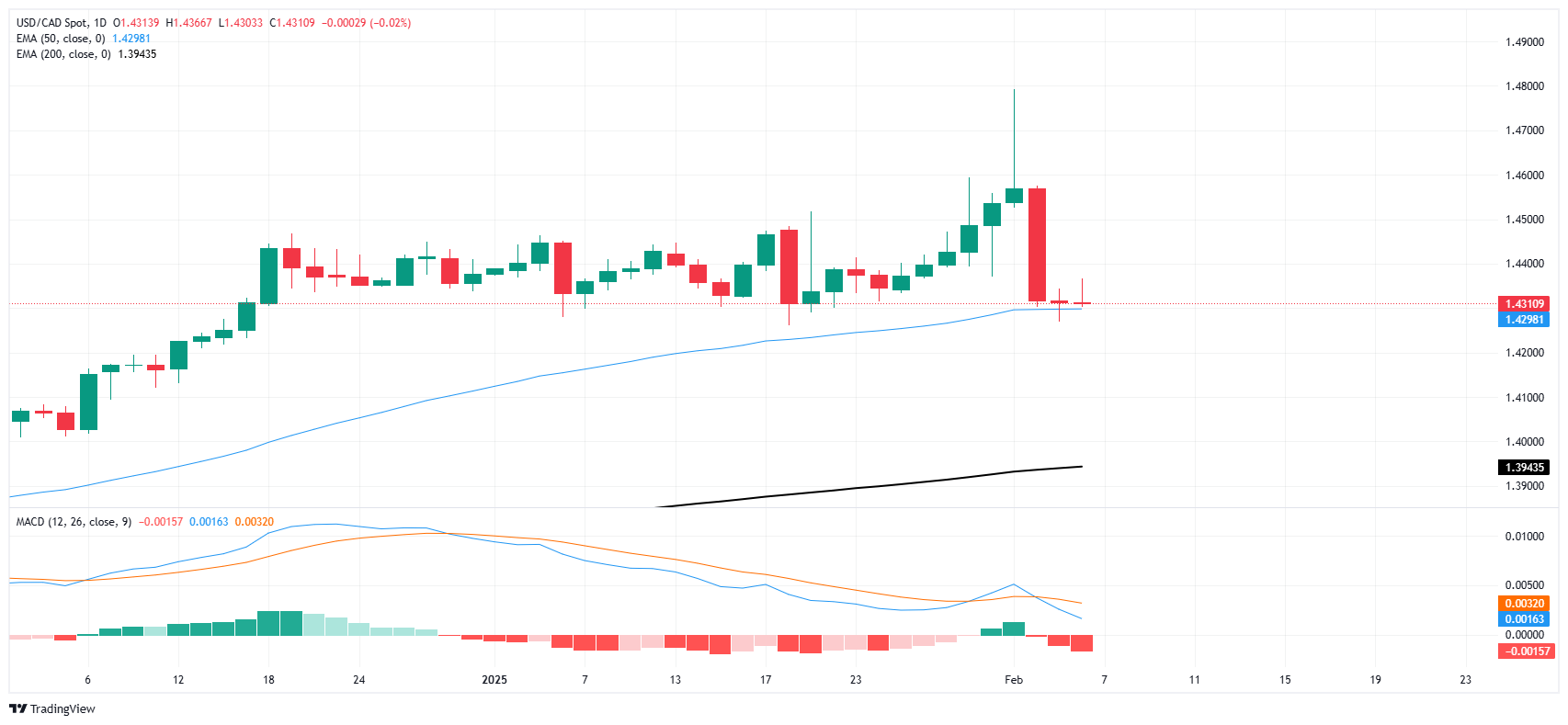Canadian Dollar flattens ahead of key labor prints
- The Canadian Dollar churned on Thursday, holding flat against the Greenback.
- PMI figures from Canada contracted sharply in January, limiting Loonie gains.
- Key US NFP and Canadian employment figures are due on Friday.
The Canadian Dollar (CAD) spun in a tight circle on Thursday, churning chart paper near 1.4300 against the US Dollar (USD) as markets gear up for another Nonfarm Payrolls (NFP) Friday. Markets are treading water near familiar levels as investors shrug off the early week’s trade war fears and resume focusing on hopes for future Federal Reserve (Fed) rate cuts.
Canadian Purchasing Managers Index (PMI) figures for January sharply missed the mark on Thursday. Canadian Net Change in Employment and Average Hourly Wages numbers are due on Friday but will be overshadowed by the much larger US NFP jobs data package.
Daily digest market movers: Canadian Dollar flattens ahead of NFP
- The Canadian Dollar has fought back from 21-year lows this week, but remains trapped in familiar consolidation territory against the Greenback.
- Canada’s Ivey PMI for January contracted sharply on a seasonally adjusted basis, falling to a four-year low of 47.1.
- US tariffs on Mexico and Canada have been kicked down the road by another 30 days, and market tensions are loosening for the time being.
- US tariffs on China are still in place, as are reciprocal tariffs on the US from China, but these tit-for-tat import fees are largely symbolic and markets are expected to circumvent them quickly.
- Canada is expected to add far fewer jobs in January compared to December, down to 25K from 90.9K, and the Canadian Unemployment rate is forecast to tick up to 6.8% from 6.7%.
- Friday’s US NFP is likewise expected to shift lower to 170K net new jobs additions from 256K, but bumper labor prints from earlier in the week could signal an upside surprise.
Canadian Dollar price forecast
With key data due to wrap up the trading week, the Canadian Dollar is stuck back in familiar consolidation territory against the US Dollar. USD/CAD remains hung up on the 1.4300 handle, at the bottom end of a choppy sideways grind that has kept the pair traveling horizontally since mid-December.
The Loonie tumbled early this week to a 21-year low against the Greenback, sending USD/CAD to a two-decade high near 1.4800, but the move was unsustainable and the pair is now back to its middling ways. Price action is drawing into the midrange at the 50-day Exponential Moving Average (EMA), and it will take a material shift in markets to punch in new technical levels.
USD/CAD daily chart
Canadian Dollar FAQs
The key factors driving the Canadian Dollar (CAD) are the level of interest rates set by the Bank of Canada (BoC), the price of Oil, Canada’s largest export, the health of its economy, inflation and the Trade Balance, which is the difference between the value of Canada’s exports versus its imports. Other factors include market sentiment – whether investors are taking on more risky assets (risk-on) or seeking safe-havens (risk-off) – with risk-on being CAD-positive. As its largest trading partner, the health of the US economy is also a key factor influencing the Canadian Dollar.
The Bank of Canada (BoC) has a significant influence on the Canadian Dollar by setting the level of interest rates that banks can lend to one another. This influences the level of interest rates for everyone. The main goal of the BoC is to maintain inflation at 1-3% by adjusting interest rates up or down. Relatively higher interest rates tend to be positive for the CAD. The Bank of Canada can also use quantitative easing and tightening to influence credit conditions, with the former CAD-negative and the latter CAD-positive.
The price of Oil is a key factor impacting the value of the Canadian Dollar. Petroleum is Canada’s biggest export, so Oil price tends to have an immediate impact on the CAD value. Generally, if Oil price rises CAD also goes up, as aggregate demand for the currency increases. The opposite is the case if the price of Oil falls. Higher Oil prices also tend to result in a greater likelihood of a positive Trade Balance, which is also supportive of the CAD.
While inflation had always traditionally been thought of as a negative factor for a currency since it lowers the value of money, the opposite has actually been the case in modern times with the relaxation of cross-border capital controls. Higher inflation tends to lead central banks to put up interest rates which attracts more capital inflows from global investors seeking a lucrative place to keep their money. This increases demand for the local currency, which in Canada’s case is the Canadian Dollar.
Macroeconomic data releases gauge the health of the economy and can have an impact on the Canadian Dollar. Indicators such as GDP, Manufacturing and Services PMIs, employment, and consumer sentiment surveys can all influence the direction of the CAD. A strong economy is good for the Canadian Dollar. Not only does it attract more foreign investment but it may encourage the Bank of Canada to put up interest rates, leading to a stronger currency. If economic data is weak, however, the CAD is likely to fall.
